Graffiti is defined as writing or drawings which are scribbled, scratched, or sprayed illicitly on a wall or other surface in a public place. Some paintings are composed ahead of time in a sketch book. Others involve the use of portable stencils. Also included in street art is the use of small stickers, usually political in nature. Wheat pasting of posters has become nearly obsolete, though it was once very popular.
Most graffiti in the Twin Cities area is found along railroad properties and on rail cars. It is also found on abandoned and seemingly abandoned properties and buildings. A lesser amount is found on public utility boxes and power or traffic poles and even sidewalks.
Graffiti is viewed as property vandalism by some and public art by others. Some graffiti is indeed artistic, while much of it is simply tagging of a word or name to as many locations as possible. In that sense it is viewed as an eyesore. In the 1980s and 1990s graffiti was used by criminal gangs to mark territory or make threats.
Modern graffiti has now morphed into legal solicited murals on commercial buildings to highlight the artistic elements of illegal graffiti. Legal and illegal graffiti will be considered here.
According to Kate Murphy in “the Growler,” in 2016, 8,059 graffiti cases were reported in Minneapolis. In 2021, by June 9, there were 3700 reports in Minneapolis for the year (Patch/CBS, June 9, 2021).
“Dave Aeikens, public affairs coordinator for the Minnesota Department of Transportation’s metro division, says the department painted over or removed more than 2,500 tags in the Twin Cities says from 2018 to 2020, giving priority to vulgar, racist or offensive displays. “‘We tracked it back three years. It’s cost us about $100,000 in paint,’ Aeikens said” (CBS/Patch, June 9, 2021).
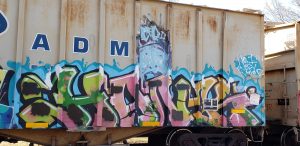
Spray paint on a rail car in the Hiawatha Milling District in Minneapolis. ADM (Supermarket to the World) stands for Archer-Daniels-Midland Company. (Photo by Twin Cities Almanac, November 2020).

Graffiti on abandoned K-Mart building at Nicollet and Lake Street in Minneapolis. Very soon afterward, it was painted over by the US Postal Service which acquired the building as a temporary post office replacing the burned out one a block away following the civil unrest related to the killing of George Floyd. (Photo by Twin Cities Almanac, taken through cyclone fencing, November 2020).
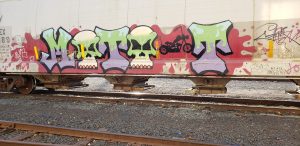
Spray paint on a rail car in the Hiawatha Milling District in Minneapolis. (Photo by Twin Cities Almanac, November 2020).
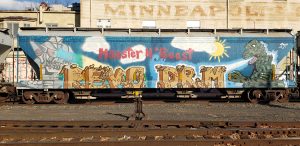
Spray paint on a rail car in the Hiawatha Milling District in Minneapolis. (Photo by Twin Cities Almanac, November 2020).
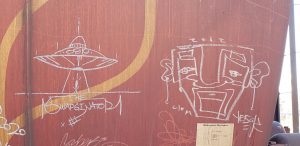
Unique small art space ship drawings on a rail car in the Hiawatha Milling District in Minneapolis. (Photo by Twin Cities Almanac, November 2020).

Small art drawings of rats on a rail car in the Hiawatha Milling District in Minneapolis. (Photo by Twin Cities Almanac, November 2020).
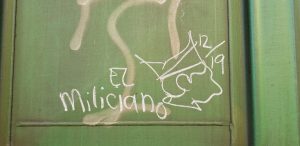
Small art drawings on a rail car in the Hiawatha Milling District in Minneapolis. The numbers 12/19 indicates the date of the graffiti is from December 2019. (Photo by Twin Cities Almanac, November 2020).
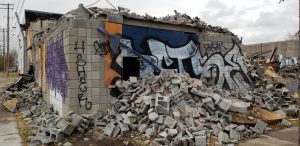
In the aftermath of the Lake Street rioting in May of 2020, this graffiti is among the first wave of succession, occurring even before the building was demolished (Some was present beforehand). It had already destroyed by fire and exhibited signs of collapse. Address is 26th Ave. S. at 28th St. East. (Photo by Twin Cities Almanac, Fall 2020).
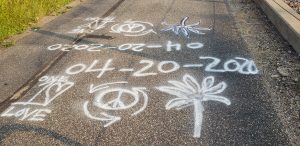
Not all graffiti appears on vertical surfaces. This simplistic drawing is on the surface of an asphalt biking trail near Cedar Ave. S. & Franklin Ave. E. The date 04-20-2020 is a reference to marijuana. The black outline of the apparent marijuana leaf indicates the painter may have been interrupted. (Photo by Twin Cities Almanac, November 2020).

A particular style of giant graffiti is presumably made with a pressurized container like a 2 1/2 gallon water fire extinguisher. In this instance the graffiti in on the back of a shopping center parapet wall that can be seen from the Blue Line light rail train near Hiawatha & Lake Street in Minneapolis. This style can be seen in several areas of the city. (Photo by Twin Cities Almanac, October 2020).
Headlines & Resources
Minneapolis graffiti artists create art above the law. City Pages, 2011.
Officer statue in Eagan vandalized with anti-police graffiti. By Paul Walsh, Star Tribune, August 7, 2020.
Street Art & Graffiti Art: Developing an Understanding Street Art & Graffiti Art: Developing an Understanding. By Melissa L. Hughes. Ernest G. Welch School of Art and Design, Georgia State University; 2009.
“Gangs and Graffiti: A Minneapolis Perspective.” Karl H. Van D’Elden. In, Vandalism: Research, Prevention, and Social Policy. US Dept of Agriculture, 1992.
Graffiti Bridge, former M&StL Railroad Crossing, Eden Prairie, MN. John A. Weeks III. 2020.
B107.2 Classic Rock. 2014.
